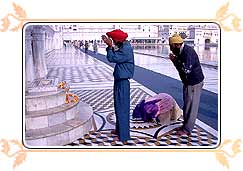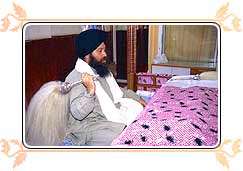 About Sikh Religion
About Sikh ReligionNanak Sikhism is one of the youngest world religion. It is a strictly monotheistic faith, preaching the existence of only one God, and teaching universally acceptable ideals of honesty, compassion, humility, piety, social commitment, and above all tolerance for other religions.
What Is Sikhism Religion
The word 'Sikh' is derived from the Sanskrit word 'shishya' which means a disciple, a learner, a seeker of truth. A Sikh believes in One God and the teachings of the Ten Gurus, embodied in the Eternal Shabad Guru, Sri Guru Granth Sahib ji. The Basic beliefs must be followed in Sikhism. Additionally, a Sikh must also partake Amrit, the Sikh religion beliefs of Baptism. Every sikh is supposed to follow the Sikh Code of Discipline. The founder of Sikh religion were Guru Nanak Dev Ji in the beginning of the sixteenth century. The succeeding nine Gurus nurtured, developed and preached his ideas and teachings. The pontificates of the nine successors of Guru nanak were only the extensions of Guru nanak's work leading to origin of Sikh religion. It is significant to note that five of the successors of Guru Nanak also composed under the name 'Nanak' implying thereby that there is no difference between the compositions of the successor and the founder.
Sikhism Religion Beliefs
Guru Gobind Singh Ji, the tenth Guru installed,in 1708, Guru Granth Sahib ji as his successor and the permanent Guru of the Sikhs and brought to an end to the line of human Gurus. Earlier, on Baisakhi day of 29th March,1699 The Birth of The Khalsa took place.
The Sikh Gurus provided guidance for about 240 years. They taught the basic values of freedom, brotherhood, charity, obedience, understanding, sympathy, patience, humility, simplicity, and piety, and outlined the path to spirituality in life. The Gurus themselves said that they were human beings and were not to be worshipped as God. They considered themselves to be mere servants of God.
Sikh Religion History
The Sikh religion was founded by Guru Nanak, who was born in 1469 CE in the village of Talwandi, now called 'Nankana Sahib' near Lahore (Pakistan). Right from his childhood his keen mind would not accept all the groundless rituals, superstitions and dogmas which passed for religion in those days.
Guru Nanak and the nine Gurus, who succeeded him, set a wonderful example of living spiritually, while yet taking an active part in the world. The tenth Nanak, Guru Gobind Singh (1666-1708 CE) evolved the Sikh initiation ceremony in 1699 CE; and thus gave a distinctive identity to the Sikhs. The first Five Initiated Sikhs were named Panj Piaré (Five Beloved Ones), who in turn initiated the Guru on his request - an event hitherto unknown in the history of mankind.
Shortly before passing away the Guru ordained that Guru Granth Sahib, the Sikh Scripture (the sacred Sikh religion book), would be the ultimate spiritual authority for the Sikhs and the temporal authority would vest in the Khalsa Panth - the Sikh Commonwealth. Guru Granth Sahib was compiled and edited by the fifth Nanak, Guru Arjan in 1604 CE. This is the only scripture in the world, which has been compiled by the founders of a faith during their own lifetime.
Gurudwara - The Sikh Place of Worship
Gurdwara (the door or abode of the Guru) is the name given to the Sikh place of worship, commonly addressed as Sikh temple in the western world. "Temple" is a misnomer in context of a Gurdwara and the Sikhs object to the use of this word for their place of worship. To understand the objection of the Sikhs to the word "temple", imagine how a Christian would react if St Peter's Basillica is called "a Catholic Synagogue" or a "Christian Mosque". In the Gurdwara, the Sikh scripture is recited and sung and its exegesis done. Guru Granth Sahib is placed on a high palanquin under a canopy in the middle of one end of the hall. The Gurdwara is a place where the "Word of the Guru" reigns supreme, not only in its recitation but also in practice. It won't be an overstatement to say that a Sikh's life revolves around the Gurdwara, which is why wherever there are even ten Sikh families, they establish a Gurdwara. All the ceremonies relating to birth, initiation, marriage, death and celebration of festivals centers around the Gurdwara.
The Five Takhts
'Takht' which literally means a throne or seat of authority is a result of historical growth of Sikhism. There are five Takhats. The first and the most important one was established by Guru Hargobind in 1609. It is called 'Akal Takht' (the Throne of the Timeless God) and is situated just opposite the gate of Harmandar Sahib - The Golden Temple, Amritsar. The Guru established it, because he thought that secular political matters should not be considered in the Golden Temple, which is meant purely for worship of God. Here the Guru held his court and decided matters of military strategy and political policy. Later on, the Sikh commonwealth (Sarbat Khalsa) took decisions here on matters of peace and war and settled disputes between the various Sikh groups.
 The
Sarangi singers sung the ballads of the Sikh Gurus and warriors at this
place and robes of honour (saropas) were awarded to persons who rendered
distinguished services of the community of men in general. The second seat
of authority is called "Takhat Sri Patna Sahib". The Five Takhts
are the five gurudwaras and these have a very special significance for the
Sikh community. Takht means a throne. They are considered the seats of Sikh
religious authority. The important decisions concerning the religious and
social life of the Sikh community have been taken here.
The
Sarangi singers sung the ballads of the Sikh Gurus and warriors at this
place and robes of honour (saropas) were awarded to persons who rendered
distinguished services of the community of men in general. The second seat
of authority is called "Takhat Sri Patna Sahib". The Five Takhts
are the five gurudwaras and these have a very special significance for the
Sikh community. Takht means a throne. They are considered the seats of Sikh
religious authority. The important decisions concerning the religious and
social life of the Sikh community have been taken here.